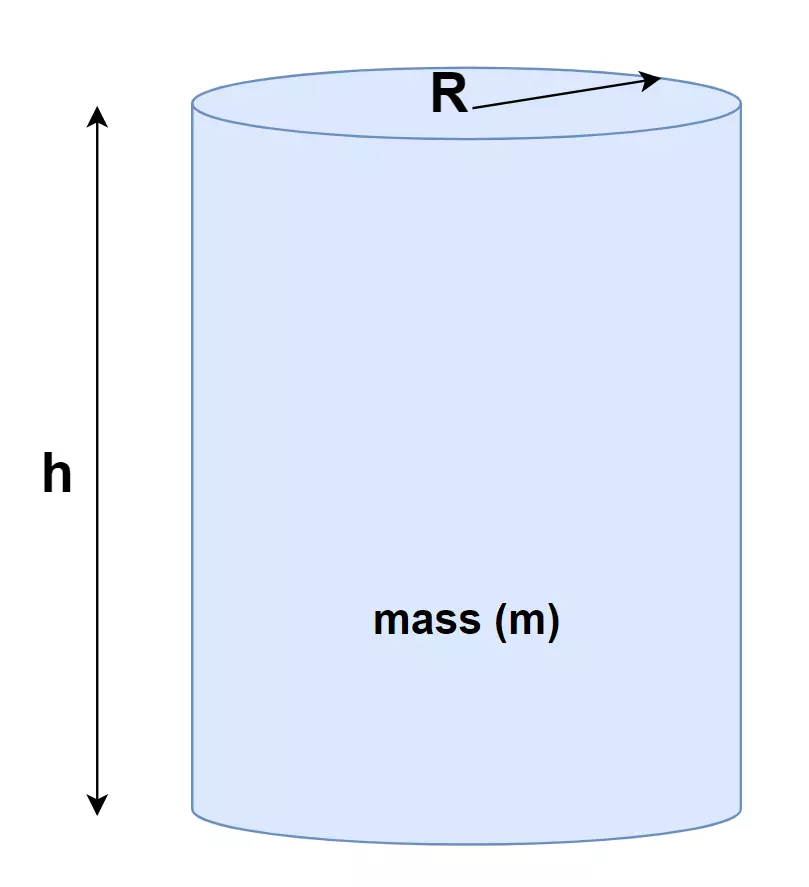Understanding the Moment of Inertia of a Cylinder
The moment of inertia is a fundamental property of an object that describes its resistance to rotational motion. For a three-dimensional object like a cylinder, there are different moments of inertia associated with different axes of rotation. The moments of inertia for a cylinder are Iz, Ix, and Iy, which represent the moments of inertia about the z-axis, x-axis, and y-axis, respectively.
Moment of Inertia of Cylinder Calculator

Formula for Moment of Inertia of a Cylinder
The formula for the moment of inertia of a solid cylinder depends on its mass (m), radius (r), and height (h).
For the moment of inertia about the z-axis (Iz), the formula is given by:
Iz = (1/2) * m * r^2
This formula shows that the moment of inertia about the z-axis depends solely on the mass of the cylinder and the square of its radius. It is independent of the cylinder’s height.
On the other hand, the moments of inertia Ix and Iy, which represent the moment of inertia about the x-axis and y-axis, respectively, are different.
These moments of inertia are calculated using the parallel axis theorem, which states that the moment of inertia about an axis parallel to an axis through the center of mass is equal to the sum of the moment of inertia about the center of mass and the product of the mass and the square of the distance between the two axes.
The formula for Ix and Iy is given by:
Ix = Iy = (1/12) * m * (3 * r^2 + h^2)
In this formula, the mass of the cylinder, its radius squared, and its height squared are taken into account. The additional factor of 3 in the formula for Ix and Iy compared to the formula for Iz arises due to the distribution of mass along the height of the cylinder.
Steps to Calculate Moment of Inertia for a Cylinder:
To calculate the moments of inertia of a cylinder, you need to know the mass, radius, and height of the cylinder. Here’s a step-by-step guide on how to calculate Iz, Ix, and Iy:
- Gather the necessary information: Obtain the mass (m), radius (r), and height (h) of the cylinder.
- Calculate Iz: Use the formula Iz = (1/2) * m * r^2. Square the radius, multiply it by half of the mass, and you’ll have the moment of inertia about the z-axis.
- Calculate Ix and Iy: Utilize the formula Ix = Iy = (1/12) * m * (3 * r^2 + h^2). Square the radius and height, multiply the radius squared by 3, add the height squared, and multiply it all by one-twelfth of the mass. This will give you the moments of inertia about the x-axis and y-axis.
- Interpret the results: The values obtained for Iz, Ix, and Iy represent the moments of inertia of the cylinder about their respective axes. These values quantify the cylinder’s resistance to rotational motion around each axis. A larger moment of inertia implies greater resistance to rotational acceleration.
By calculating Iz, Ix, and Iy, you can understand the rotational behavior of a cylinder and predict how it will respond to applied torques or rotational forces.
Conclusion
The moment of inertia of a cylinder is a fundamental property that describes its resistance to rotational motion. By using the appropriate formulas, Iz, Ix, and Iy can be calculated based on the mass, radius, and height of the cylinder. Understanding the moments of inertia of a cylinder is crucial in various fields, including physics, engineering, and mechanics, as it helps in designing and analyzing rotational systems involving cylindrical objects.
Discover the latest in Mechanical Engineering field:
.

Types of gears – their advantages, limitations, and uses with PDF
Gears are widely used transmission devices and are available in different shapes and sizes….
![Disc vs drum brakes: What is the difference? [with PDF]](https://mechanicalpost.site/wp-content/uploads/2021/09/Disc-brakes-vs-drum-brakes.png)
Disc vs drum brakes: What is the difference? [with PDF]
There is a high probability that the vehicle you own might be equipped with…

What is a Drilling machine? definition, types of drilling machines, and operations
The drilling process is simple itself. Probably the most straightforward technique of subtractive machining…
What if you fill diesel in a petrol car? | The Mechanical post
Engines are the heart of conventional automobiles. The majority of automobiles work on either…
How to design a machine ? Detailed steps | The Mechanical post
Product designer, Industrial designers all would agree that designing a machine is the first…

What Is Mechanical Engineering? The Ultimate Guide You’ll Need
Introduction From the towering skyscrapers that define our urban landscapes to the intricate machinery…


